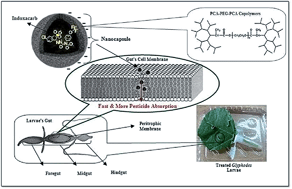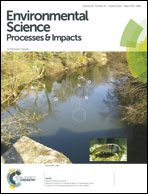Linear-dendritic copolymers/indoxacarb supramolecular systems: biodegradable and efficient nano-pesticides†
Abstract
Photodegradable and biocompatible nano-indoxacarb was prepared successfully by encapsulation of indoxacarb with poly(citric acid)–poly(ethylene glycol)–poly(citric acid) (PCA–PEG–PCA) ABA type linear-dendritic copolymers both with (nano-IND/TiO2) and without (nano-IND) TiO2 nanoparticles via supramolecular interactions. Preparation of nano-indoxacarb by both formulae was confirmed using spectroscopy and microscopy analyses. TEM images showed small particles with average sizes of 10 nm for nano-IND and 12 nm for nano-IND/TiO2. Interestingly, the rate of degradation of indoxacarb in both nano-IND/TiO2 and nano-IND exposed to UV and natural light was higher than that for free indoxacarb in the presence of TiO2 nanoparticles. Furthermore, results of bioassay experiments on the model pest showed that the essential dosage of pesticide for pest control significantly decreased when nano-IND and nano-IND/TiO2 were used. Because of the higher loading capacity and slower release rate for indoxacarb from nano-IND than from nano-IND/TiO2, and because TiO2 nanoparticles show toxicity in bioassay experiments, nano-IND is introduced as a promising and eco-friendly pesticide system.


 Please wait while we load your content...
Please wait while we load your content...